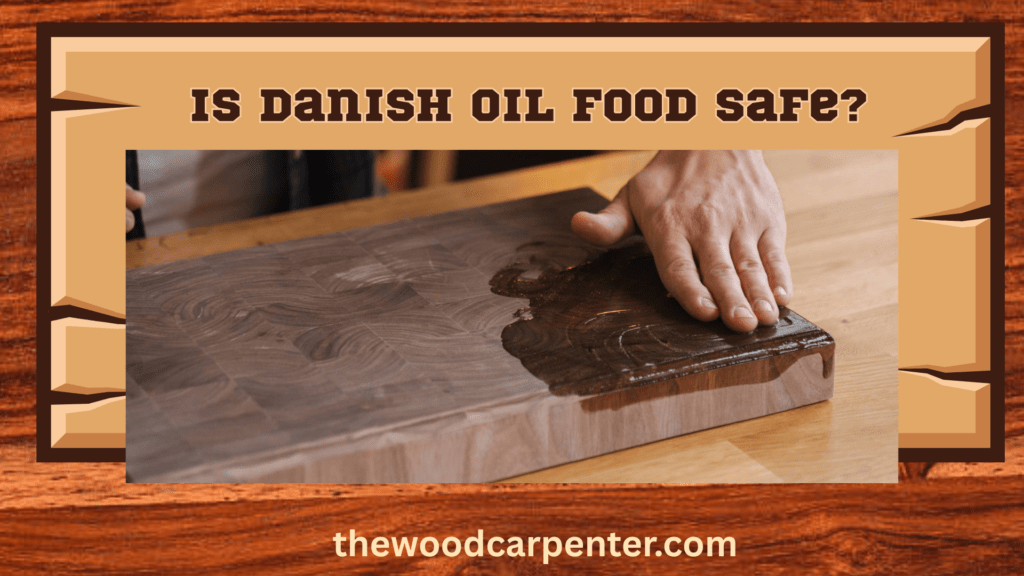
When finishing your wood projects or treating your wooden pieces—such as a chopping board, kitchen countertop, or a wooden utensil you made for yourself—safety comes first. A frequently asked question by wood workers and DIY enthusiasts; “Is Danish Oil safe for use with food?”
Yes—Danish Oil can be food safe but only after it has fully dried and cured. But there are some critically key things that you should know about what it’s made of, how it cures, and ways it can best be used safely.
In this guide, we’ll go through what Danish Oil is made of, find its ingredients, see if it truly is food safe, and, of course, discuss whether you’d be fine using it, and where you should use it ( and shouldn’t use it ).
What is Danish Oil ?
Danish oil is a combination of natural oils, varnish, synthetic resins and a solvent. Unlike pure oils, it’s a “hard-drying” finish, which not only penetrates a wood’s grain but cures into a hard, impervious, water-resistant surface.
It’s widely used for:
- Furniture finishing (tables, chairs, cabinets)
- Kitchen worktops and wooden utensils
- Toys and decorative wooden items
- Outdoor furniture (when maintained properly)
The satin finish showcases the wood grain pattern and protects against water, stains, UV rays and scratches.
Is Danish Oil Food Safe ?
The Short Answer:
Yes, Danish Oil is indeed food safe when fully cured.
Here’s why:
During the curing process, the occurring oils and resins polymerize (harden) into a non-toxic surface.
Once cured, the gloss has never leached harmful chemicals into food.
The majority of good quality Danish Oils offer it as safe for utensils, worktops, even toys—once its dried.
The Important Caveat:
Not all Danish Oils are created equal. Some brands may contain additives, dryers or resins that are not consistent in safety. When using it in the kitchen, always look for “food safe once cured” on the product label.
How Long Does Danish Oil Take to Cure?
Dry Time: 6–8 hours between coats (drying times may vary from brand to brand).
Time to hard cure: Full cure can take 7-30 days depending on temp/thickness/humidity.
Food-Safe Phase: Once Danish Oil is completely cured, it is considered food safe.
Tip: If you’re not sure it’s set, let it go a little longer. When properly cured, the substrate should not be tacky, oily or odorous.
Where is Danish Oil Safe to Use ?
✅ Safe Applications (once cured):
- Kitchen countertops
- Wooden serving trays
- Bowls, spoons, and utensils
- Furniture and toys
⚠️ Not Ideal For:
Cutting Boards and Countertop – Danish Oil can get rancid over time with continuous food contact and washing. For cutting boards, use food-grade mineral oil or beeswax.
Benefits of Using Danish Oil as a Finish
Food-Safe Once Fully Cured – Non-toxic after it has fully cured and safe for incidental food contact.
Adds Beauty – Deeply penetrates wood to accent the grain.
Scratch and Stain Resistant – Resists damage with anti-scratch design.
Easy Application – Easy brush-on or wipe-on application.
Cheap – Readily available and low cost when compared to specialty finishes.
Alternatives to Danish Oil for Food-Safe Wood Finishes
If you’re looking for a fully food-safe alternative, consider:
- Pure Tung Oil (100% natural and waterproof)
- Mineral Oil (Odorless and non-toxic)
- Beeswax and Carnauba Wax Blends (Provide a natural, protective coat)
- Shellac (Natural and commonly used for food-safe coatings)
How to Use Danish Oil Safely
Prepare the Wood – Sand the wood down and clean off dust.
Spread Oil Evenly – Rag or brush, stand for 10–15 minutes.
Wipe A-Way Excess – Eliminates a sticky finish.
Let Dry – 6–8 hours between coats.
Again – Use 2–3 coats for the best application.
Cure Time: Allow the project to cure for 1 – 4 weeks before using with food.
⚠️ Safety Note: Dispose of oily rags with caution—linseed and Danish oil rags can catch fire on their own if crumpled and left unattended. Spread them flat to dry, or soak in water before disposal.
Key Differences: Danish Oil vs. Other Wood Oils
| Feature | Danish Oil | Tung Oil | Teak Oil | Linseed Oil |
|---|---|---|---|---|
| Food Safe? | Sometimes | Yes | No | Yes (Boiled Linseed Oil may not be) |
| Waterproof | Semi | Yes | Yes | No |
| Drying Time | 4-6 Hours | 24-48 Hours | 4-6 Hours | 24-72 Hours |
| Finish Type | Satin | Matte | Glossy | Matte |
| Application Uses | Furniture, Countertops | Cutting Boards, Bowls | Outdoor Furniture | Wooden Utensils |
Danish Oil vs. Mineral Oil for Food Contact
| Feature | Danish Oil | Mineral Oil |
| Food Safety | Safe when cured | Always food safe |
| Durability | Hard, water-resistant finish | Needs frequent reapplication |
| Appearance | Enhances grain with satin sheen | Invisible finish |
| Best Use | Countertops, furniture, utensils | Cutting boards, butcher blocks |
If you are finishing a cutting board, mineral oil or beeswax would be the preferable selection. Danish Oil is nice- reclaimed for countertops or serving utensils.
Danish Oil Food Safety FAQs
1. Can I use Danish Oil on cutting boards?
Not recommended. It can become rancid with multiple washings. Use mineral oil instead.
2. How long does it take for Danish Oil to be food safe?
From about 7 to about 30 days, depending upon curing conditions.
3. Does Danish oil expire on wood?
Yes — it can smell, on cutting boards and other high-contact surfaces.
4. Is it safe to use Danish Oil on children’s toys?
Yes, if fully cured and marked food safe.
5. Is Danish Oil good for Tung or Linseed?
Danish Oil is less fussy to apply than Linseed Oil, dries faster, and is more durable. Yes, pure tung oil is also food safe but requires more time to cure.
Final Thoughts
So, is Danish Oil food safe?
Yes — but not until it has cured completely. It’s a great finish for furniture, kitchen countertops, and wooden utensils when both appearance and durability are desired.
For direct cutting surfaces, just use food-grade mineral oil or beeswax. Must apply according to the product label, adhere to appropriate curing times and enjoy the beauty of natural Danish oil.

